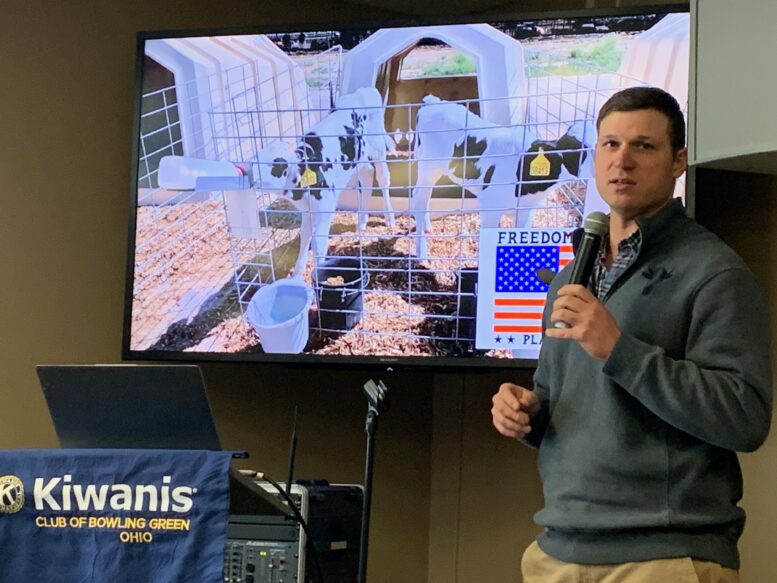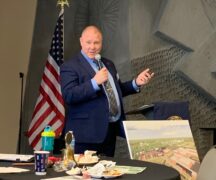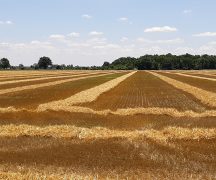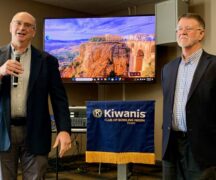By JULIE CARLE
BG Independent News
Bowling Green Kiwanis Club had another lesson in agriculture on Thursday thanks to longtime farmer and club member Paul Herringshaw who invited local farmers and agricultural business leaders to share their stories during the January club meetings.
From overseeing dairy production and dairy herd genetics to managing manure and truck traffic, Will Leone described the work that goes into owning and operating Carlyle Dairy Farm in nearby Wayne. He and the Bouma family from Texas are partners in the Wayne dairy and three Texas dairy operations.
Leone, a New York native and Cornell-educated veterinarian, started as the herd veterinarian for the Boumas in Texas before transitioning into dairy management. The partners bought the Wayne dairy operation that was originally built by the Vreba-Hoff Investor Group.
He and his wife and two children moved to the Carlyle farm in 2021. They milk 3,300 cows three times a day. Though the numbers qualify the farm as a megafarm, Leone said, “We are truly family farmers. We make our money milking cows, and we borrow our money from Farm Credit, just like everybody else.”
The operation is a free-stall dairy where the cows are housed inside for climatic protection. “We can cool them in the summer with fans and soakers, and in the winter we drop curtains and let their BTUs warm the place,” he said.
Daily milk production is 270,000 pounds or 32,500 gallons of milk per day. Currently, he sends the milk to Michigan “to fill a need at the Fairlife facility, which is undergoing an expansion,” he said. Previously the milk was going to the Meijer bottling plant in Tipp City, Ohio.
Leone also talked about the work he does with breeding animals to make dairy replacements and beef crossbred calves. The crossbred calves combine the traits of a larger-framed beef sire with a dairy animal that brings marbling to the cross. These animals are raised specifically for beef production.
“We call them beef on dairy in the industry, and they are gaining tremendous traction now because the U.S. beef herd is suffering from drought in the west,” he said. “Because in the dairy industry we need to have calves every day of the year, we are able to smooth out the seasonality of the beef production in the west and produce a more consistent animal.”
In addition to producing a lot of milk and beef cross calves, Leone said they also produce a lot of fertilizer in the form of manure.
The 40 million gallons of manure that comes from the cows is equivalent to 280 tons of phosphorus, 565 tons of potash and 300 tons each of ammonium nitrogen and organic nitrogen.
The fertilizer they produce displaces fertilizer that otherwise would be imported into the area, often from outside of the U.S., he said, admitting that “manure is a bit of a touchy issue at times.”
They try to apply all of their manure via a drag line rather than trucking it across local roads. Using a 10-inch hose and pumps, the manure can be moved up to eight miles.
“Working with the Wood County Engineer’s Office has been very helpful at gaining right of ways, closing roads at times and working with neighbors,” he said.
The application process is heavily regulated in Ohio, which means every application has to be prescribed to the field. The Ohio Department of Agriculture inspects the operation twice a year and looks at all their records to make sure what they are putting on the fields balances with the number of acres and the production.
The weather is a mitigating factor for application timing, which means the manure cannot be applied if there is a 50% chance of rain.
Everything they apply is injected into the soil. They have the ability to check tiles hourly until the risk of runoff has dissipated. “We will plug tiles if we have to, but generally, we don’t have to do anything like that,” he said.
The Carlyle farm has 27 employees and spends $5 million dollars in “nonfeed expenses” each year. He also purchases more than $5 million in local feed, including corn silage, corn and ground corn, all within about a four-mile radius from the farm.
Additionally, he purchases 5,200 tons of soybean meal that equates to 218,000 bushels of soybeans, that comes from the ADM plant in Fostoria. “Very, very, very little of what we feed the cows comes from no further away than 15-20 miles,” he said
“Everything we do is to maximize efficiencies and production,” Leone said. “If you think of a dairy cow as maintenance requirement, they need to eat a certain amount to maintain homeostasis, keep their heart beating and move around.”
All the milk that is produced above that maintenance requirement improves efficiency. Leone and his team do their best not to stress the cows, who spend eight hours a day eating, three hours milking, and the rest of the time sleeping.
“We give these cows a nice sand bed to lay in so they want to lay down, ruminate and rest,” he explained. “They don’t have to walk very far (to be milked). They go to a barn with a full bunk of feed, eating about 100 pounds per animal per day.”
Leone is still able to provide veterinary care, but he also spends a lot of time on sanitation, nutrition and protocols. He sees his work as a bovine public health official.
“I don’t like to see problems because problems are hard to fix. My goal is to prevent problems,” he said.





